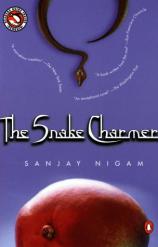The Snake Charmer
About the Book
The Snake Charmer
The Snake Charmer begins with a perfect moment. Sonalal, a middle-aged snake charmer from Delhi, is plying his trade for a group of tourists. Raju, his prized snake, is performing beautifully, responding attentively to the music Sonalal plays on his been. It is as if the snake, the music, and Sonalal are—along with the reader—all bewitched, and, for a few minutes, Sonalal experiences the joy that comes when our inner and outer worlds become one. For most of us, moments like this are few and far between. What is tragic about Sonalal's experience is that his attempt to prolong his euphoria results in its utter desecration when he destroys the very thing that has made his happiness possible. Raju, exhausted, wants to stop dancing. Sonalal urges him to continue. But when the snake charmer hits a false note, the snake rebels, biting his master. In a fit of rage, Sonalal bites Raju in two. The moment is over and the results of Sonalal's attack are disastrous. Sonalal's quest to recapture his perfect moment, and his regret over its destruction, will consume the rest of his life.
With lucid and lyrical prose, Nigam effortlessly weaves humor, realism, metaphor, and cultural commentary, luring the reader into Sonalal's voyage of self-discovery and his quest for the ineffable. Beneath the smooth-sailing surface of the novel, the writer is tackling some very big philosophical and cultural issues. The power of the novel in part derives from the reader's sense that the story is both universal and particular to a time and place. Modern-day India is a country of clashing cultures, a place where disparate forces coalesce and factionalize the population. Nowhere in India is that clash of cultures more apparent than in Delhi, with its chaotic blend of ancient temples and new construction projects, its fly-by-night businesses and generations-old practices, its brothels and teahouses and open-air markets, its oppressive heat and seemingly eternal monsoons.
Although Nigam makes reference to some of the political and social factors that characterize contemporary Delhi—including the accidental death of Sanjay Gandhi, the government's attempts to sterilize adult males, the increase in economic and class mobility, and clashes between Hindus and Muslims—it is in Sonalal's family life that we witness the profound changes taking place in India today. Like many members of his caste, Sonalal is poor and unschooled, carving out a life in a crowded, disordered city. But unlike the generations of snake charmers before him, Sonalal has a chance to overcome his poverty. His sons will be educated and able to achieve careers and knowledge beyond what Sonalal could ever have hoped for. His wife's dreams of prosperity are, just barely, within reach. Sonalal's passion, snake charming, is perceived by most of the population, including his family, as a shtick performed solely for the busloads of foreign and native tourists that visit the city. Nevertheless, he is content to live his life working at his ancestral trade, secure in the knowledge that he is the world's most talented practitioner of a dying art form. Standing at the crossroads, where the old and new India converge, Sonalal is confused, misunderstood, and searching for ways to satisfy his many desires.
It is this very search, motivated by the deepest sorrow and a yearning for redemption, that moves us to sympathize and empathize with this frail and slightly comical man, who, though hardly of Ulysses-like stature, is nonetheless caught up in an odyssey of mythical proportions—so fundamental are the questions he grapples with. Racked by physical and emotional pain, he seeks help from all quarters: doctors, sex therapists, magicians, prostitutes, and fellow snake charmers. Bombarded with facts and ideas that leave his head spinning and his heart aching, Sonalal must sift through the "science" to find his own truth. Why do we destroy the things we love? What is real and what is magic? And, in the end, what does any of it mean? Sonalal's perfect, fleeting moment, and its devastating, all-too-human end, catapult him to a level of consciousness few of us have the courage to withstand. His heroic, painful attempts to divine life's greatest mysteries leave us wondering if he wouldn't have been better off never having experienced "the ether that flows through the universe." But it also leaves us, like Sonalal, grappling with questions as universal and unanswerable as those posed in the song of Kabir that Reena sings to him:
From which place did you come? And to which shore do you fly? Where will you stop to rest? And what are you looking for?
The Snake Charmer
- Publication Date: August 20, 2012
- Paperback: 223 pages
- Publisher: Penguin (Non-Classics)
- ISBN-10: 0140278915
- ISBN-13: 9780140278910


